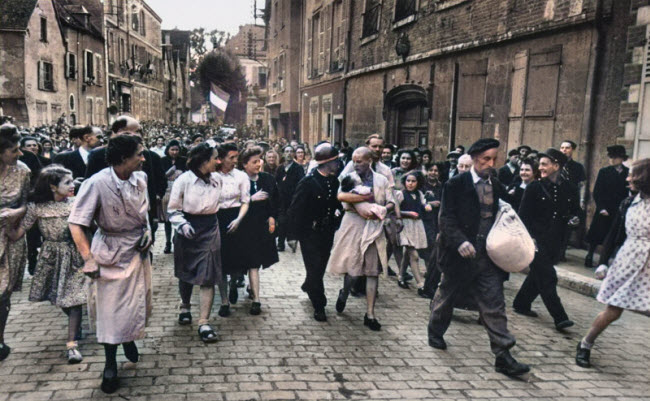Date: August 16, 1944
Photographer: Robert Capa – American War Photographer
Details : In the final days of World War II, as Allied forces entered and liberated French cities from the Nazis, French citizens began seeking revenge against those who had collaborated with the German forces during the occupation. One notable case was Simone Touseau, the subject of a notorious photograph. In this image, Touseau’s head is shaved, and she has a hot iron mark on her forehead, all while holding her infant daughter amidst the jeers of a surrounding crowd. This photograph was published globally in the renowned American magazine Life and widely circulated in newspapers as a symbol of the brutal purges in France.
In the aftermath of Germany’s defeat and the Allied forces’ advance into France, a mixture of jubilation and a thirst for retribution led the French to form civilian committees, composed of resistance fighters and local citizens, to settle scores with collaborators. A massive cleansing operation ensued, resulting in the arrest of many women who had either cooperated with or been romantically involved with German soldiers. These women were paraded through the streets, subjected to public humiliation, shaved heads, and in some cases, beatings, torture, or even rape and murder.
At this time, war photographer Robert Capa was with the Seventh Armored Division as it advanced through France, having just liberated the Chartres area the day before the photograph was taken. As the fighting subsided and the Allies gained control, Capa began documenting the events, capturing the scene where French citizens had gathered the women who had collaborated with the Germans in the courtyard of a municipal building. A hairdresser was summoned to shave their heads, and Simone Touseau, depicted in the photograph, was the only one among them to be branded with a hot iron on her forehead. They were then paraded through town in a humiliating procession, surrounded by onlookers. Capa followed this parade and took the photograph of Simone Touseau holding her daughter, Catherine, born a few months earlier from her relationship with a German soldier, with her father, George, and partially visible mother, Germaine, accompanied by police officers and a group of citizens.
The image first appeared in the United States three weeks later in Life magazine, sparking public curiosity about the woman’s identity and her story. Simone Touseau, a beautiful 23-year-old Frenchwoman at the time, was the youngest daughter of a couple who ran a dairy and fish shop during the Great Depression. Raised in a conservative Catholic environment, Touseau’s family faced financial hardship, which led them to embrace extreme right-wing ideologies. Consequently, Simone became infatuated with Nazi ideas and even suggested to her friends that France needed its own Hitler.
When World War II broke out and Germany invaded France, Simone Touseau learned German and worked as a secretary and translator. She met and fell in love with a 32-year-old German soldier, Erik Ose, with whom she began an open relationship. After Erik was transferred to the Eastern Front and was injured, he returned to his hometown in Bavaria for recuperation. Simone followed him to Germany, volunteered as a nurse in Munich, and became pregnant with his child. When they attempted to marry, the German authorities refused and sent her back to France. Her father nearly killed her for bringing shame to the family, but she gave birth to her daughter, Catherine, while Erik was killed near Minsk in Belarus.
Unfortunately, after returning to France, Simone’s family was accused by the Nazis of anti-German activities and was sent to a concentration camp. Simone and her family were blamed for denouncing their neighbors, which contributed to their punishment. Following the public shaming and shaving depicted in the photograph, Simone Touseau and her mother, Germaine, were accused of denouncing five local residents, leading to their deportation to the Mauthausen concentration camp in Austria. Two of the accused died there. The women were imprisoned while their father was left free, considered a kind man unable to control his family. Simone’s older sister, Annette, cared for Catherine during their imprisonment. After nearly three years of trials, Simone and her mother were released due to insufficient evidence, but Simone was later tried again in a civil court and sentenced to ten years of suspended prison.
After her release, Simone and her family moved from Chartres and settled elsewhere. She found work at a pharmacy and married an accountant in November 1954, having two children with him. She visited Germany several times with her daughter, Catherine, to see Erik’s family. However, Simone later lost her job, her family fell apart, and she became a heavy drinker, succumbing to depression before dying in 1966 at age 44. Catherine, her daughter, refused to discuss the past and revealed to a journalist in 2010 that she had destroyed photographs and letters between her mother and Erik Ose, keeping her children completely away from that history.
